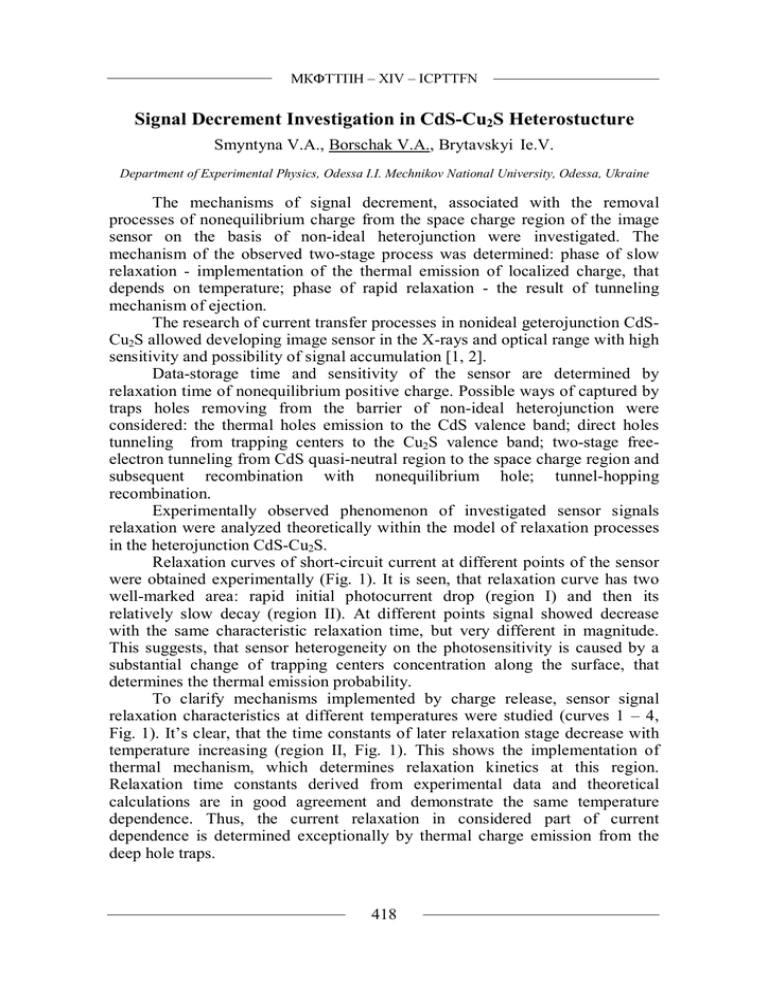Signal Decrement Investigation in CdS
advertisement

– X V – ICPTTFN Signal Decrement Investigation in CdS-Cu2S Heterostucture Smyntyna V.A., Borschak V.A., Brytavskyi Ie.V. Department of Experimental Physics, Odessa I.I. Mechnikov National University, Odessa, Ukraine The mechanisms of signal decrement, associated with the removal processes of nonequilibrium charge from the space charge region of the image sensor on the basis of non-ideal heterojunction were investigated. The mechanism of the observed two-stage process was determined: phase of slow relaxation - implementation of the thermal emission of localized charge, that depends on temperature; phase of rapid relaxation - the result of tunneling mechanism of ejection. The research of current transfer processes in nonideal geterojunction CdSCu2S allowed developing image sensor in the X-rays and optical range with high sensitivity and possibility of signal accumulation [1, 2]. Data-storage time and sensitivity of the sensor are determined by relaxation time of nonequilibrium positive charge. Possible ways of captured by traps holes removing from the barrier of non-ideal heterojunction were considered: the thermal holes emission to the CdS valence band; direct holes tunneling from trapping centers to the Cu2S valence band; two-stage freeelectron tunneling from CdS quasi-neutral region to the space charge region and subsequent recombination with nonequilibrium hole; tunnel-hopping recombination. Experimentally observed phenomenon of investigated sensor signals relaxation were analyzed theoretically within the model of relaxation processes in the heterojunction CdS-Cu2S. Relaxation curves of short-circuit current at different points of the sensor were obtained experimentally (Fig. 1). It is seen, that relaxation curve has two well-marked area: rapid initial photocurrent drop (region I) and then its relatively slow decay (region II). At different points signal showed decrease with the same characteristic relaxation time, but very different in magnitude. This suggests, that sensor heterogeneity on the photosensitivity is caused by a substantial change of trapping centers concentration along the surface, that determines the thermal emission probability. To clarify mechanisms implemented by charge release, sensor signal relaxation characteristics at different temperatures were studied (curves 1 – 4, Fig. 1). It’s clear, that the time constants of later relaxation stage decrease with temperature increasing (region II, Fig. 1). This shows the implementation of thermal mechanism, which determines relaxation kinetics at this region. Relaxation time constants derived from experimental data and theoretical calculations are in good agreement and demonstrate the same temperature dependence. Thus, the current relaxation in considered part of current dependence is determined exceptionally by thermal charge emission from the deep hole traps. 418 – X V – ICPTTFN Figure 1: Sensor signal relaxation (of short-circuit current) at different temperatures: 1–T=15°C, 2–T=25°C, 3–T=40°C, 4–T=60°C. Such parameters as magnitude and the slope of initial part of the photocurrent decay (region I, Fig. 1) don’t depend on temperature. This demonstrates the implementation of photocurrent relaxation mechanism in this region, which isn’t due to the thermal release and has apparently, tunneling character. Assessing the contribution of tunneling mechanisms in trapped charge relaxation was carried out by calculating the barriers tunneling transparency coefficients for the corresponding transitions. Calculations were made taking into account the changes of potential barrier shape under illumination [3]. The lack of temperature dependence of relaxation curve is due to the fact, that the values of barriers tunneling transparency coefficients don’t depend on temperature. Account of tunneling processes leads to characteristics harmonization of the short-circuit current relaxation curves obtained experimentally and theoretically. Research results, that are discussed in this work, enabled to supplement the modeling of developing sensor optoelectrical characteristics and to compare fabrication parameters with processed CdS-Cu2S films properties. 1. Vassilevski D.L., Vinogradov M.S., Borschak V.A. Photon induced modulation of surface barrier: investigation and application for a new image sensor // Applied Surface Science. – 1996. – 103. – pp. 383-389. 2. Smyntyna V.A., Borschak V.A., Kutalova M.I., Zatovskaya N.P., Balaban A.P. Sensor on the basis of nonideal heterojunction for registration of the Xray images // in Proc. of EUROSENSORS XVIII Conference, Rome, September 12-15. – 2004. 3. Borschak V.A., Smyntyna V.A., Brytavskyi E.V., Balaban A.P., Zatovskaya N.P. Dependence of Conductivity of an Illuminated Nonideal Heterojunction on External Bias // Semiconductors. – 2011. – vol. 45. – pp. 894-899. 419



